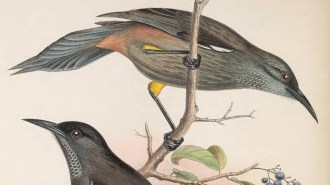After Invasions: Can an ant takeover change the rules?
A rare before-and-after study of the invasion of an exotic species shows the newcomer swiftly disassembling the community, say ant biologists.
Before Argentine ants (Linepithema humile) swept into a nature preserve in northern California, some 20 species of native ants worked the landscape in largely segregated domains, says Nathan Sanders of Humboldt State University in Arcata, Calif. However, the invaders wiped out that pattern, Sanders and his colleagues report in an upcoming Proceedings of the National Academy of Sciences.
“This is the first time anyone has shown how fast an invasion can disassemble a community,” says Sanders.
The data in the new paper are “very striking and will cause a lot of ecologists to think,” says Thomas E. Miller of Florida State University in Tallahassee.
The small but prolific Argentine ant, which is native to South America, has made itself at home in warm climates on six continents. It was first reported in the United States in New Orleans in 1891, and now it occupies 21 states. The invading ants typically wipe out many species of native insects and can cause food shortages for insect eaters, such as horned toads, and create crises for ant-dispersed plants (SN: 10/20/01, p. 252).
Sanders attributes the Argentine ants’ success primarily to its superior foraging and piracy of other ants’ food finds.
As the ant moved north through California, “we tried to take advantage of a natural experiment,” Sanders says. In 1993, he and his colleagues started monitoring Jasper Ridge Biological Preserve to see what native ant species appeared together in each of 133 circular, 40-meter-diameter test plots. The team’s analysis showed that before the arrival of the Argentine ant, native species were less likely to share a habitat than chance would predict. This might indicate that competition made species keep their distance.
Applying the same analysis after the invasion, the researchers no longer detected the segregated pattern of native-ant associations. The species were either scattered at random or members of two species turned up together more often than chance predicted.
After looking at 7 years’ of data, the researchers note that the loss of the segregated pattern occurred rapidly, sometimes during the first year of the invasion.
The invasive ant is changing the basic rules by which the studied community operates, says Sanders.
Miller, however, says that he’s not ready to accept the idea that the Argentine ants disassembled the community. He was intrigued by the instances in which species seemed to preferentially occur together after the invasion. “Perhaps, it’s just assembled in a different way,” Miller says.
****************
If you have a comment on this article that you would like considered for publication in Science News, please send it to editors@sciencenews.org.






